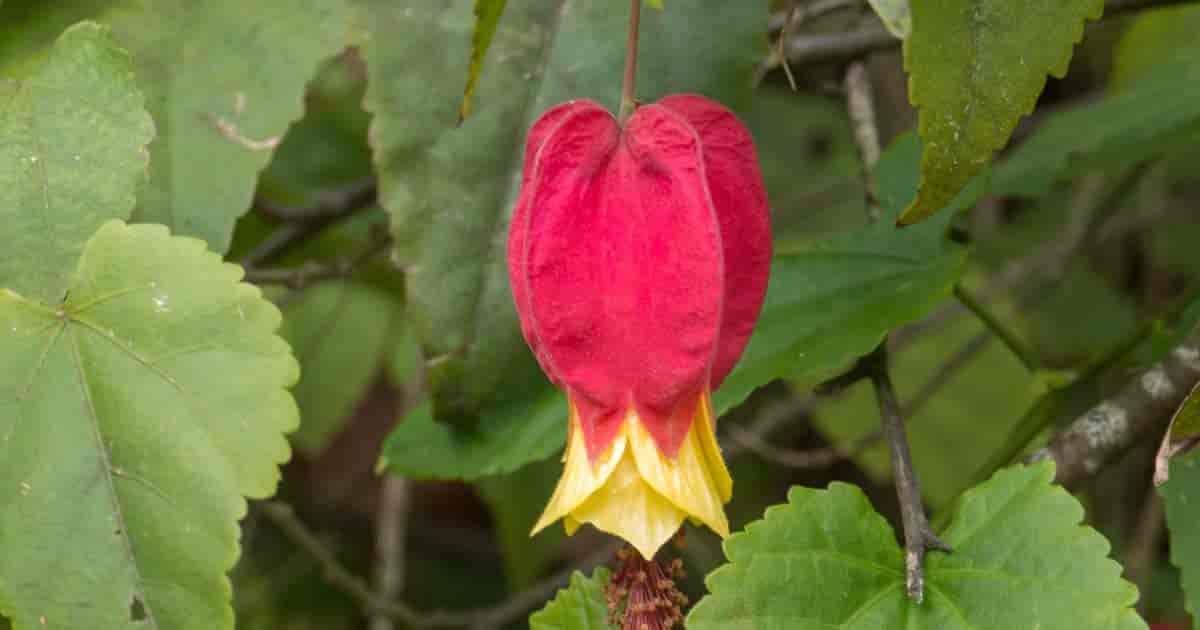[ad_1]
Abutilon megapotamicum [a-BEW-tih-lon meg-uh-poh-TAM-ih-kum] aka flowering maples, are graceful, fast-growing plants with trailing stems. It often blooms throughout most of the year, offering extra color from spring to fall and possibly winter.
Other common names for the flowering maple include:
- Trailing Abutilon
- Brazilian bell flower
- Chinese lantern
The Brazilian bellflower is native to warm, semi-tropical Southern Brazil and neighboring regions. However, it makes a lovely addition to an enclosed porch or sunroom.
Abutilon Flowering Maple Care
Size and Growth
The flowering maple features thin stems and slender green leaves. The willowy stems tend to hang, making them a perfect hanging plant or train stems on a trellis or hoop.
It also grows quickly, growing up to 4′ feet tall in a single season.
Flowering and Fragrance
The colorful flowers are the main highlight of this plant. The lantern-like, colorful bell-shaped flowers with yellow petals bloom from late spring and last through the fall.
- Under the right conditions, the flowers last into the winter.
- The flowers dangle from long stalks and include a large, bulbous calyx.
- From the red-orange bud, the yellow corolla appears resembling lanterns, upside-down vases, or balloons.
- The flowers have no scent but are pretty to look at throughout the year.
Light and Temperature
This native Brazilian plant enjoys full sun and grows in most regions. But, recommended for USDA hardiness zones 7 to 10. However, it doesn’t tolerate frost.
When planted outdoors, give it partial shade in the summer. Strong direct sunlight, especially the midday sun, may be too much for this plant to survive.
Besides direct sunlight, the flowering maple doesn’t do well in strong winds and drafts. If possible, try to shelter it by growing it on a trellis.
When grown indoors, plants thrive at normal room temperature throughout most of the year.
In the winter, it enjoys slightly cooler temperatures but never below 60° degrees Fahrenheit.
Watering and Feeding
Abutilon requires plenty of water during the warmer months. From March to August, check the plant daily. Plants quickly start to wither after drying out.
In the winter, the plant doesn’t need as much water. Just make sure the soil never dries out.
When fertilizing, feed the plant once per week during the active growing season.
Soil Type and Transplanting
The flowering maple grows just fine in regular well-drained soil grown indoors or outdoors.
If grown in containers or a pot, repot each spring. This encourages new growth during the warmer months. If you skip this step, the plant may not bloom.
Grooming
In the early spring, cut back the older stems to allow new stems to appear.
If the plant starts to get too long or you want to grow in a specific shape, it’s also possible to trim the stems to the desired size.
It’s typically best to perform the grooming in the spring when repotting. This provides many months of active growth for the plant to recover from the stress.
How To Propagate Abutilon ‘Chinese Lanterns’
In most cases, propagating from stem cuttings is the easiest method. But new plants are also started from seeds.
Take the cuttings in early in spring before the growing season starts. Take the cuttings when transplanting or repotting the plant while following these steps:
- Take three-inch to four-inch softwood cuttings with several leaves.
- Dip cutting in hormone powder for rooting
- Pot the cuttings in three-inch pots.
- Water the new plants and cover them with plastic.
- Cut holes in the plastic to allow ventilation.
- In several weeks, the cuttings should take root.
- The young plants should be fine in their three-inch pots.
- Some plants may need repotting by the following spring.
- This plant requires a good-size pot to support the delicate root system and prevent crowding.
Abutilon Plants Pests or Disease Problems
This easy plant to care for has no significant threats or diseases. It’s also not known to be toxic to people or pets.
- However, whiteflies, aphids, and spider mites may still pose a problem.
- Spider mites are the hardest to get rid of. Try to catch the infestation early and treat it with a miticide.
- Get rid of aphid attacks by washing them away with water or treated with an insecticide like a foliar neem oil pesticide spray.
- With whiteflies, an insecticide is often the best solution.
NOTE: When using insecticide or miticide on young plants, dilute the spray mixture to protect the delicate plant.
Suggested Abutilon Uses
This light, airy, mallow family plant member will easily help freshen any room, getting plenty of light throughout the summer. It also grows as a hanging plant when grown indoors.
Consider training the stems through a wire hoop or a trellis if grown outside. The delicate stems may not survive strong winds and weather.
You may also like the: Growing Dichrostachys Cinerea – Chinese Lantern Tree
[ad_2]
Source link









 + Planting String of Watermelon Succulents
+ Planting String of Watermelon Succulents  with Garden Answer
with Garden Answer


